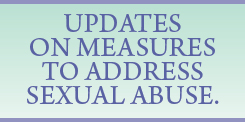SPS students' Read to Feed funds will help purchase animals for families
July 29, 2019 at 12:37 p.m.

By EmmaLee Italia | Correspondent
When teachers in St. Paul School invited representatives from the nonprofit organization Heifer International to speak about participating in its Read to Feed program in April, they were pleasantly surprised by the overwhelming response.
“There was a palpable excitement about the program,” said Jennifer Graja, early literacy and sixth-grade integrated language arts teacher, who coordinated the school’s Read to Feed participation. “Our students are filled with compassion for others and a desire to help those in need.”
Over the course of 30 days, students gathered sponsors to support their reading thousands of pages and hundreds of books, all to help purchase animals for a third world family or community. The result was astonishing.
“We have raised $4,757.50 so far,” Graja reported. “I am so very proud of our students.”
Dr. Ryan Killeen, SPS principal, said that the funds will be matched dollar for dollar through the Heifer International matching program. He added his thanks to Graja and Megan Dwyer, Upper School integrated language arts teacher, for spearheading the initiative.
Once the final funds are tallied, the school will vote on which animals to purchase from the Heifer International catalog, which offers a variety of options including sheep, goats, heifers, chickens, water buffalo, and even a “gift ark” – a combination of a variety of animals that can help sustain a community.
Heifer International volunteers Sharon Zieman and Margaret Wianecki, who had spoken to students at the beginning of the project, returned May 21 to receive the school’s pledge, as donations were still trickling in.
“The kids of almost every age get it,” said Zieman. “They understood the message, the concept that they were helping people lift themselves out of poverty.”
Wianecki agreed. “They were so responsive [when we came to present the project to them] – they had so many questions for us, and they wanted to hear more. You could tell they were excited.”
“The Read to Feed program is a great fit for us because it allowed the students to truly create positive change in the world in a very attainable way,” Graja reflected. “Students would stop me in the hallways to share how much they had read so far.”
Dr. Killeen believes that the synergy of supporting positive literacy along with social justice help make the program especially unique, and that the excitement to read continues among the students.
“A critical component of the program is the education of students on the realities of poverty and food insecurity globally,” he said. “The impact these resources will make in the lives of families around the globe is hard for us to even comprehend.”
Eddie Kuczynski, sixth grade, wanted to participate “because it would help others to survive and it would be a kind thing to do. It helps others because they don’t have the stuff that we do here.”
The Read to Feed experience taught students even more than they anticipated.
“It’s surprising how we kids in the world can really make a difference in the lives of kids who have nothing,” said seventh-grader Christabelle Sutter. “I never knew that I could really change the world. Because we are reading, they now can get animals, have food and transportation and because of that, happiness. They can really feel loved by other people in the world and love can drown out sorrows. It just feels great to make a difference.”
Jimmy Teti, third grade, read 1,000 pages for the Read to Feed effort. “If you really try, you can do so much,” he said. “It’s important because they are poor and they don’t have any money. This can help them to get food, materials to build houses, and tools to farm.”
Dr. Killeen agreed, noting how struck he was when recently discussing the program with a third grade student who was excited and proud of his participation.
“To paraphrase his words, ‘I’m a kid; I don’t usually get to change people’s lives,’” Killeen recalled. “But changing lives is exactly what our kids have done, and there is a lesson in these words for us all.”
[[In-content Ad]]
Related Stories
Sunday, December 14, 2025
E-Editions
Events
By EmmaLee Italia | Correspondent
When teachers in St. Paul School invited representatives from the nonprofit organization Heifer International to speak about participating in its Read to Feed program in April, they were pleasantly surprised by the overwhelming response.
“There was a palpable excitement about the program,” said Jennifer Graja, early literacy and sixth-grade integrated language arts teacher, who coordinated the school’s Read to Feed participation. “Our students are filled with compassion for others and a desire to help those in need.”
Over the course of 30 days, students gathered sponsors to support their reading thousands of pages and hundreds of books, all to help purchase animals for a third world family or community. The result was astonishing.
“We have raised $4,757.50 so far,” Graja reported. “I am so very proud of our students.”
Dr. Ryan Killeen, SPS principal, said that the funds will be matched dollar for dollar through the Heifer International matching program. He added his thanks to Graja and Megan Dwyer, Upper School integrated language arts teacher, for spearheading the initiative.
Once the final funds are tallied, the school will vote on which animals to purchase from the Heifer International catalog, which offers a variety of options including sheep, goats, heifers, chickens, water buffalo, and even a “gift ark” – a combination of a variety of animals that can help sustain a community.
Heifer International volunteers Sharon Zieman and Margaret Wianecki, who had spoken to students at the beginning of the project, returned May 21 to receive the school’s pledge, as donations were still trickling in.
“The kids of almost every age get it,” said Zieman. “They understood the message, the concept that they were helping people lift themselves out of poverty.”
Wianecki agreed. “They were so responsive [when we came to present the project to them] – they had so many questions for us, and they wanted to hear more. You could tell they were excited.”
“The Read to Feed program is a great fit for us because it allowed the students to truly create positive change in the world in a very attainable way,” Graja reflected. “Students would stop me in the hallways to share how much they had read so far.”
Dr. Killeen believes that the synergy of supporting positive literacy along with social justice help make the program especially unique, and that the excitement to read continues among the students.
“A critical component of the program is the education of students on the realities of poverty and food insecurity globally,” he said. “The impact these resources will make in the lives of families around the globe is hard for us to even comprehend.”
Eddie Kuczynski, sixth grade, wanted to participate “because it would help others to survive and it would be a kind thing to do. It helps others because they don’t have the stuff that we do here.”
The Read to Feed experience taught students even more than they anticipated.
“It’s surprising how we kids in the world can really make a difference in the lives of kids who have nothing,” said seventh-grader Christabelle Sutter. “I never knew that I could really change the world. Because we are reading, they now can get animals, have food and transportation and because of that, happiness. They can really feel loved by other people in the world and love can drown out sorrows. It just feels great to make a difference.”
Jimmy Teti, third grade, read 1,000 pages for the Read to Feed effort. “If you really try, you can do so much,” he said. “It’s important because they are poor and they don’t have any money. This can help them to get food, materials to build houses, and tools to farm.”
Dr. Killeen agreed, noting how struck he was when recently discussing the program with a third grade student who was excited and proud of his participation.
“To paraphrase his words, ‘I’m a kid; I don’t usually get to change people’s lives,’” Killeen recalled. “But changing lives is exactly what our kids have done, and there is a lesson in these words for us all.”
[[In-content Ad]]










